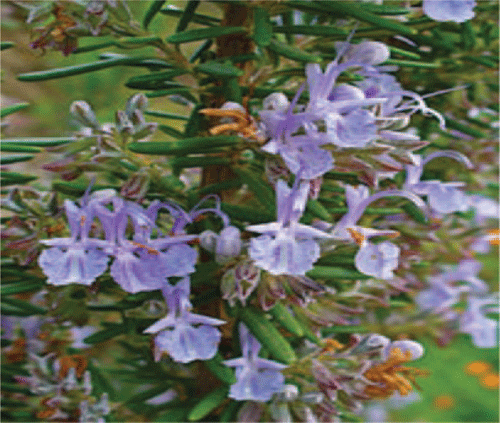Rosemary
Walsh Patrick 1Journal of Primary Health Care 11(1) 82-83 https://doi.org/10.1071/HC15940
Published: 3 April 2019
Journal Compilation © Royal New Zealand College of General Practitioners 2019.
This is an open access article licensed under a Creative Commons Attribution-NonCommercial-NoDerivatives 4.0 International License.
Rosemary is an evergreen bush perennial that grows to a height of two to six feet with pale blue flowers and spiky leathery leaves (Fig. 1). It is a member of the mint family, Lamiaceae, along with many other herbs such as oregano, thyme, basil, and lavender. The name ‘rosemary’ derives from the Latin ros marinus, which means ‘dew of the sea’. Although native to the Mediterranean landscape where it can be found growing on rocky limestone sea cliffs, it is now cultivated throughout the world as an ornamental and aromatic plant. The distillation of the flowering tops of the plant in the 13th century furnished a distillate that was known in the fragrance industry as ‘Queen of Hungary Water’. The epithet ‘officinalis’ in the plant’s botanical name originates from its well recognised medicinal properties by herbalists in ancient times.

|
Rosemary has been used as a symbol for remembrance during war commemorations and funerals in Europe, Australia and New Zealand. Mourners would throw it into graves as a symbol of remembrance for the dead. Rosemary has particular significance for Australasians, as it is found growing wild on the Gallipoli peninsula.
Botanical Name
Rosmarinus officinalis
Common Names
Rosemary, Rosmarinus officinalis, Compass Plant, Compass Weed, Encensier, Herbe Aux Couronnes, Old Man, Polar Plant, Romarin, Romarin Des Troubadours, Romero, Rose de Marie, Rose Des Marins, Rosée De Mer, Rosemarine, Rusmari, Rusmary.
Preparations
Leaves, oil, tincture.
Active Constituents
Most of rosemary’s beneficial health effects haven been attributed to the very high antioxidant activity of its main chemical constituents, including carnosol, carnosic acid, ursolic acid, rosmarinic acid and caffeic acid.
Evidence for Efficacy
‘The science-based medicinal use of plants, and preparations derived from them, in the treatment, alleviation and / or prevention of disease or injury, according to recognised standards of quality, safety, and efficacy’ is the core philosophy of the European Society Co-operative on Phytotherapy (ESCOP), which represents herbal medicine societies, including practicing medical herbalists, across Europe. ESCOP (http://escop.com/) lists the internal use of rosemary and its preparations for the improvement of hepatic and biliary function, to treat dyspepsia and mild spasmodic disorders of the gastrointestinal tract, and external use of rosemary preparations for the treatment of rheumatic conditions, peripheral circulatory disorders, promotion of wound healing, and as a mild antiseptic.
Auto-oxidation of fat and oil is one of the main factors that reduces the nutritional value of foods, by affecting product quality such as flavour, colour and texture. Rosemary, through its powerful antioxidant (https://www.superfoodly.com/orac-values/) and antimicrobial activities, has been shown to curb lipid oxidation, thus extending the shelf life and safety of foods. Furthermore, it has been reported that the addition of rosemary as a marinade to ground beef and other types of muscle meat before grilling, frying, broiling, or barbecuing can reduce the generation of carcinogenic heterocyclic amines by over 90%.1 Rosemary deserves to be called ‘an herb that is a friend of Physicians and commands the praise of cooks’ (Emperor Charlemagne, 9th century).
Posology and methods of administration
Information governing the medical use of rosemary can be obtained from the European Medicines Agency (EMA) (http://www.ema.europa.eu/ema/) herbal monograph on Rosmarinus officinalis. Oral, cutaneous, and as a bath additive are the recommended methods of administration by the EMA. In the case of the latter, the recommended bath temperature is 35–38°C, for 10 to 20 min.
Rosmarinus officinalis should be administered as per licenced manufacturer’s instructions.
If symptoms worsen during the use of the medicinal product, a doctor or a qualified health practitioner should be consulted. The use in children and adolescents aged < 18 years is not recommended due to lack of adequate data.
Safety during pregnancy and lactation has not been established. In the absence of sufficient data, the use during pregnancy and lactation is not recommended.
No research has studied the effect of rosemary on the ability to drive and use machines.
Contraindications
Oral use
Obstruction of bile duct, cholangitis, liver disease, gallstones and any other biliary disorders that require medical supervision and advice.
Use as bath additive
Full hot baths are contraindicated in cases of large skin injuries and open wounds, acute skin diseases, high fever, severe infections, severe circulatory disturbances and cardiac failure.
Adverse Effects
Hypersensitivity (contact dermatitis and asthma) has been reported but their frequency is not known. If other adverse reactions occur, a doctor or a qualified health care practitioner should be consulted.
References
[1] Puangsombat K, Scott Smith J. Inhibition of heterocyclic amine formation in beef patties by ethanolic extracts of rosemary. J Food Sci. 2010; 75 T40–7.| Inhibition of heterocyclic amine formation in beef patties by ethanolic extracts of rosemary.Crossref | GoogleScholarGoogle Scholar | 20492265PubMed |


